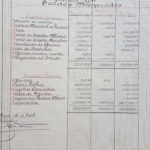A brief history of BBVA (X): Accounting difficulties in the Civil War
One of the thorniest consequences for the banking industry of the outbreak of the war and the country’s division into two opposite sides was the inability to carry accurate and reliable accounting records. Already in 1936, after barely six months of conflict, banks were not able to close their accounting books.

Bookkeeping blindness
The events that took place in early 1937 forced Republican banks to reinvent their accounting procedures. Since they had no control over the branches on the national side, they lacked the required information to carry their books. Under these circumstances, for example, it was impossible to convene the Annual General Meetings without breaching the institutions’ own bylaws.
However, unsurprisingly, this regulatory compliance zeal did not last long. On the eve of the summer, a rollover system was validated, which allowed to file a verification statement at year end, and a budget halfway through the year. This formula was used both in 1937 and 1938.
The successive loss of territory that the republican army suffered, forced banks to transfer their ledgers from one location to the other, depending on how the conflict progressed. In some cases, custodians had to give up documentation before they even had the chance to attempt to move it. The state of the accounting records of Republican banks worsened as time wore on, bringing nothing but more hardship to the interests of the entities.
Unlike branches on Republican soil, banks on the National side were not subject to accounting supervision from a central authority. A few months after the war started, National banks were offered an accounting truce, in recognition of the inability to truthfully verify the records submitted by each institution. The temporary exemption was first approved by the National Banking Committee based in Burgos and later ratified by Franco’s government. The decree was validated in February and remained in force for a four-year period, until February 1941. However, banks were required to apply for the exemption on a yearly basis, and the granting thereof was subject to the approval of the banking authority of the National side and the self-appointed Ministry of Finance.

Banco de Bilbao's frozen balances
With a Spain increasingly dominated by Franco, a law was promulgated on October 13, 1938 requiring all banks on the insurgent side to rebuild their accounting records. Thus, different organs, consisting of both government and bank personnel, were set up and commissioned to expedite the tidying up of the accounting inconsistencies that existed between the branches on the National side and the ones progressively assimilated thereto. The aforementioned law required freezing the balances of the assets and liabilities that failed whose accuracy could not be verified due to the absence of accounting records. This circumstance was clearly detrimental to the interests of both bank creditors and those that had entrusted their savings to these institutions, who were rendered defenseless to legally claim their rights.
The accounting records were rebuilt between the parties involved and interested in each bank’s statement of accounts. Given the daunting effort that the lack of documentation entailed, third parties were appointed to mediate in those cases in which the different sides struggled to reach an agreement. The decisions made were granted a provisional status, to provide for the possibility of future clarifications based on the surfacing of relevant documentation or information.
The Spanish banking network abroad
In 1936, the Spanish banking system abroad consisted of the offices of the Bank of Spain and Banco Exterior – as regards official banking bodies – and Banco de Bilbao’s foreign branches and some correspondent arrangements set up by Banco Central, Banesto and Banco Hispano Americano, on the private banking side.
The Bank of Spain had offices in the capitals of France, Germany and United Kingdom, and one in Tangiers, back then an international protectorate. Banco Exterior opened offices in the U.S., the United Kingdom, France and Belgium shortly after the outbreak of the war.
Among private banks, Banco de Bilbao’s was the largest network beyond Spanish borders. Bilbao had opened its Paris and London branches in 1902 and 1918, respectively, and also had an office in Tangiers.

Current image of the building that hosted Banco de Bilbao's branch in Tangiers
Banesto worked abroad through correspondent agreements with foreign banks and Banco Hispano and Banco Central focused their foreign businesses mainly on Latin America. Banco Central had set up an exclusive correspondent agreement with Banco Exterior in Río de la Plata. Banco Español - a consortium set up under Primo de Rivera’s regime by thirteen regional banks of northern Spain, with Banco Guipuzcoano as the most prominent of them all - had an office in Paris.
The international operations of Spanish banks soon became another source of disputes between Republicans and insurgents. The supply of resources for the war depended, to a large extent, on the possibility to establish adequate financial channels. And in this aspect, the National side fared quite better than the Republican side, or at least it did not run into as much trouble as its enemy did. The financial markets of the most powerful countries (United Kingdom, France and the United States) did not trust the Republican government and although the latter used Banco Exterior’s network to make swaps and operations, its standing was far from being optimal.
On the other hand, the National side’s Banco Exterior channeled currencies from other institutions and centralized its monetary normalization operations in Spanish territories in Equatorial Guinea. From there, it expanded its radius of action to the Canary Islands and Sidi Ifni. This progression allowed other countries to start doing business with Franco’s banking system.
Banco de Bilbao, the only Spanish institution with its own international banking network, faced a very particular situation. With its central headquarters based in Bilbao, the bank was not only subject to interference from both sides of the conflict, but also the Basque government. Banco de Bilbao’s foreign network offered the possibility to control a succulent source of foreign currency, and thus its Paris and London branches soon became the object of increasing attention from all sides.
For Nationals, Republicans and Basques the lack of legal sovereignty over the London and Paris branches soon became a hurdle. As if this were not enough, the staff’s stubbornly prioritized business interests over the particular interests of any sides, further increased the complexity of the situation. Determined to prevent external interferences, bank officials went as far as expelling Antonio Sacristán - the Higher Banking Council inspector appointed by the government of the Republic in Valencia - from Banco de Bilbao’s premises in Paris.
The above referred episode did nothing but add another level of tension to the relations between the Valencia and Bilbao Governments, which led Aguirre to attempt to seize control of Banco de Bilbao’s international network by appointing Domingo Epalza as "Director of Banco de Bilbao, with indisputable character”. Epalza, a well-known Basque nationalist, declined the appointment, arguing that he would have no option but to put the interests of the bank before his nationalist convictions. As a result of this decision and "the strained relations with the Bank’s Paris branch" Luciano Ocerín was appointed government delegate in the French capital.

Domingo Epalza, Advisor of Banco de Bilbao
An agreement was reached with Epalza so that Ocerín would be able to carry out his covert inspections without raising suspicions pretending to be just another bank employee, and thus he continued working until an order was received from the Bank’s board in the National zone, urging the officials to expel him from the Paris branch. By then, Epalza had resigned from his position as director, refusing to put up with the constant political pressures he was subject to.
But the Basque government continued determined to pursue its interests, even if it mean seizing control of the Paris branch by force. Indeed, Luciano Ocerín commanded a battalion of armed Basque fighters that stormed into the office. As a result of this political intervention the branch went bankrupt.
The London branch also had its share of unfortunate episodes. The office was managed by two proxies of the bank. In March 1937 the new branch director appointed by the Basque government appeared in the London office. The proxies prevented the new director from taking office, and the matter ended being tried in court, with a ruling that, in first instance, backed the two proxies’ stance, but which nonetheless placed the branch under supervision of a court-appointed official.
The trial went on for several months without the judges nor the British government - urged by the judges – siding with any of the parties. As a result of this ongoing process, the London branch was brought to a calamitous situation, as both the external pressures and the measures imposed by the court-appointed auditor made it extremely difficult for it to run its operations.